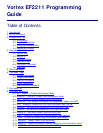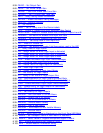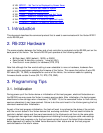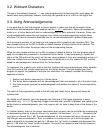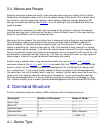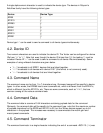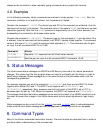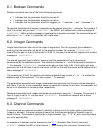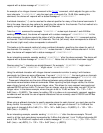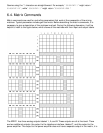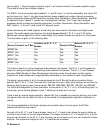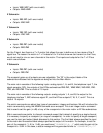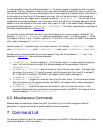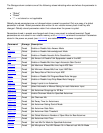
chosen as the terminator to allow manually typing commands using a simple text terminal.
4.6. Examples
In the following examples, Vortex commands are enclosed in single quotes, 'like this'. Also, the
terminator character is not explicitly shown, but its presence is implied.
Consider the command '***PING'. The device type and ID for this command are wildcards, thus the
command will be sent to all devices. The command name in this case is 'PING', and there are no data
characters (payload). Note that the 'PING' command is supported by all of the Vortex devices, thus
broadcasting the command to all devices makes sense.
Consider the command 'S**GAINIA10'. The device type for this command is 'S' and the device ID is
a wildcard, thus the command will be broadcast to all EF2211 devices linked together. The command
name in this case is 'GAINIA' and the command data (payload) is '10'. This command sets the gain
on input A of all connected EF2211's to 10 dB.
Command Effects
***PING
Requests PONG response from all linked Vortex devices.
S**GAINIA10
Sets the gain on input A of all connected EF2211 devices to 10 dB.
5. Status Messages
The Vortex sends status messages via RS-232 and EF Bus any time one of its internal parameters
changes. This means that the host program does not need to continually poll the Vortex in order to
detect status changes. Status messages are in the same format as the commands used to set the
corresponding parameter.
For example, suppose you send the command 'S**GAINIA10' and there are two EF2211's linked
together with device IDs 3 and 7. The EF2211's will respond with 'S03GAINIA10' and
'S07GAINIA10', respectively. Now, someone uses the front panel of the EF2211 set to ID 7 to
decrease input A's gain by 1 dB. When this happens, the EF2211 will respond with 'S07GAINIA9'.
This example illustrates that status messages can be sent as the result of an RS-232 command or as
the result of some other change in the Vortex device such as front panel adjustments, logic inputs,
etc.
Status messages can be turned off via the
ACKMOD command. ACKMOD refers to acknowledgement
mode since the term status message and acknowledgement are synonymous for our purposes.
6. Command Types
Many of the Vortex commands have similar formats. The main formats are described here in order to
provide a better understanding of the command set.



